From mining to toy making
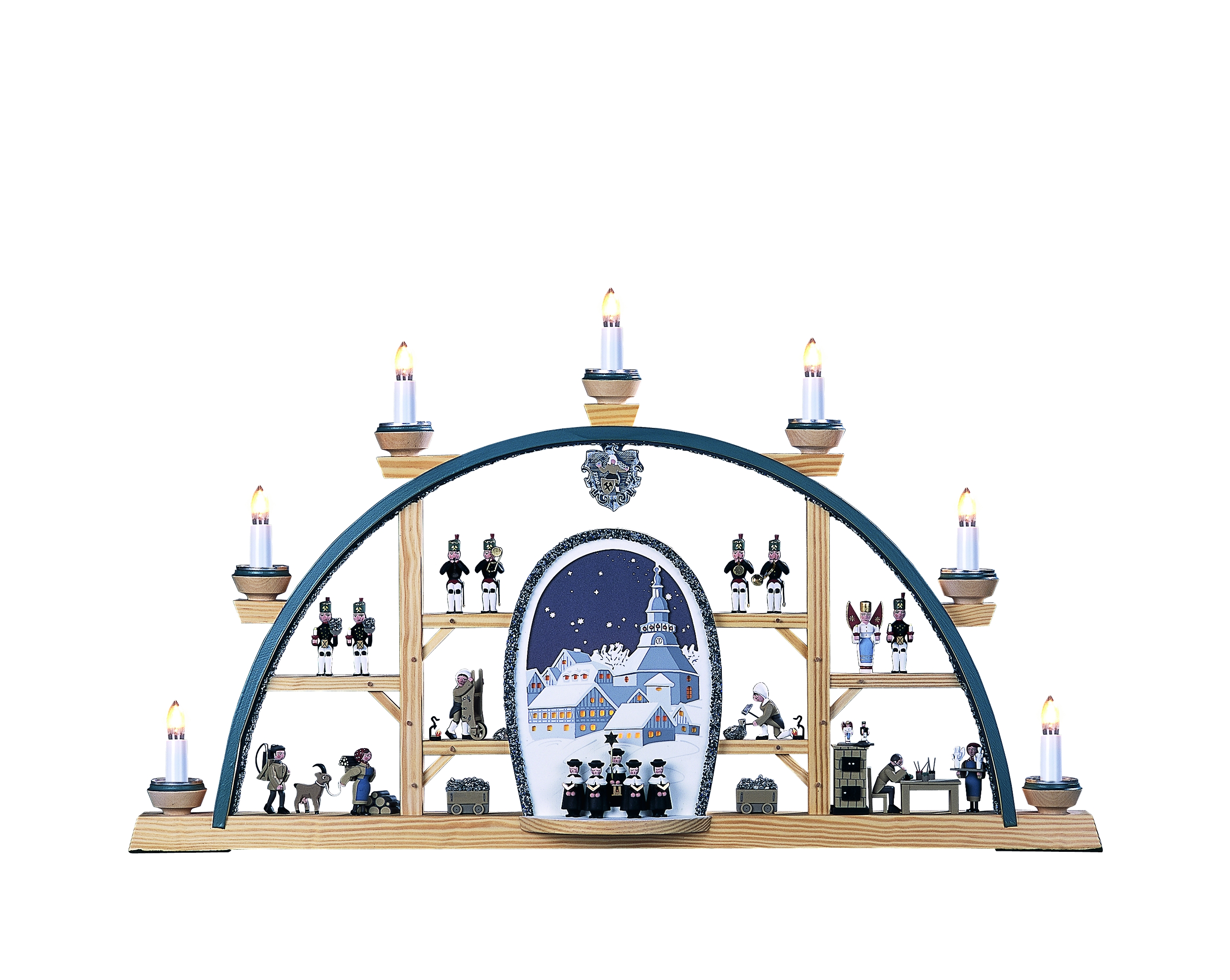
Item no. 202/160/1 (size 70 cm x 40 cm) with 8 electric candles including interior lighting, tunnel mouth hole painted on both sides
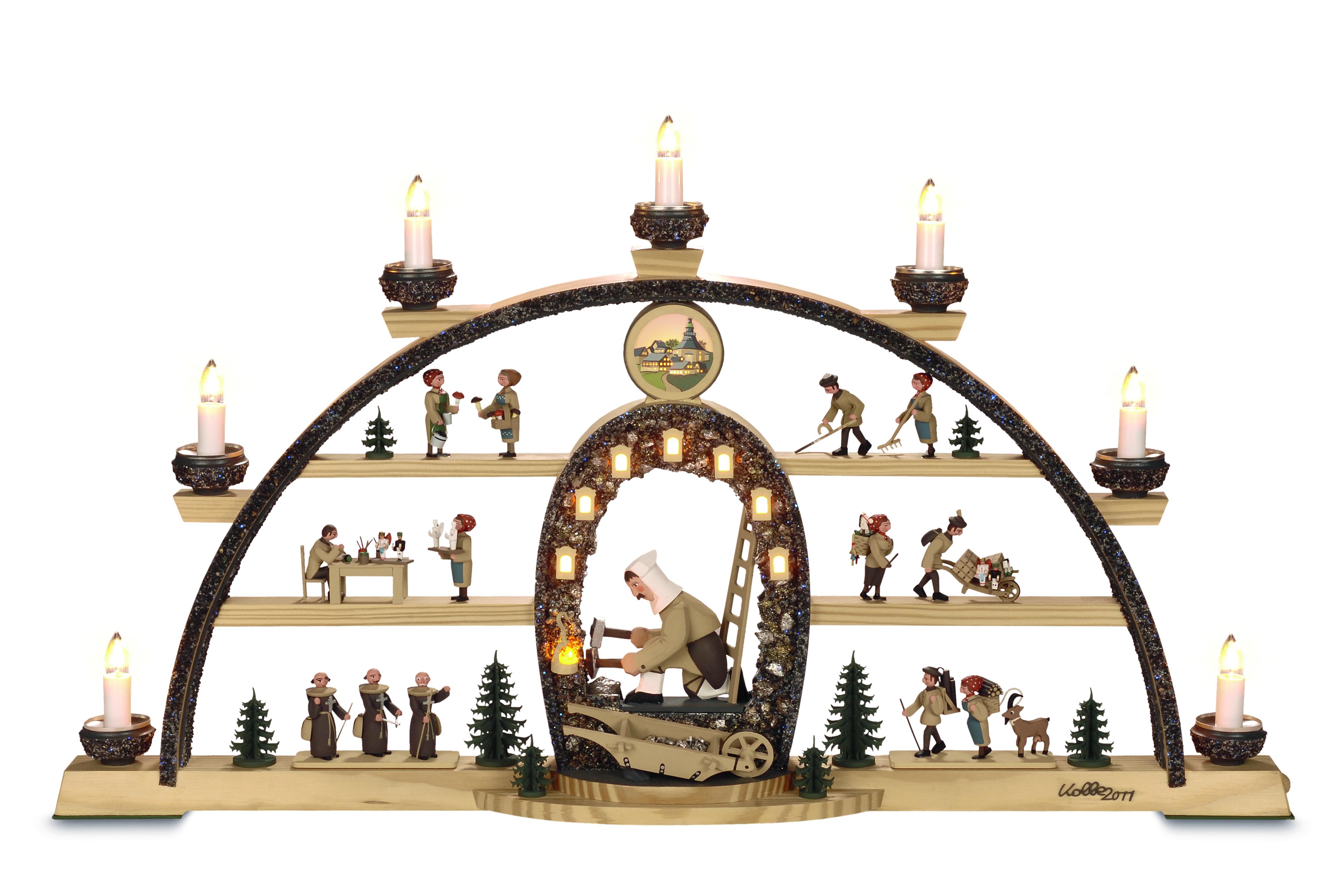
Item no. 202/160/8 (size 70 cm x 40 cm) with 7 electric candles

Image 1: Item no. 202/160/1/5 „cynsifen 1324” with mountain chapel and Cistercian monks, at the back Church of Seiffen (size 70 cm x 40 cm) with 8 electric candles including interior lighting
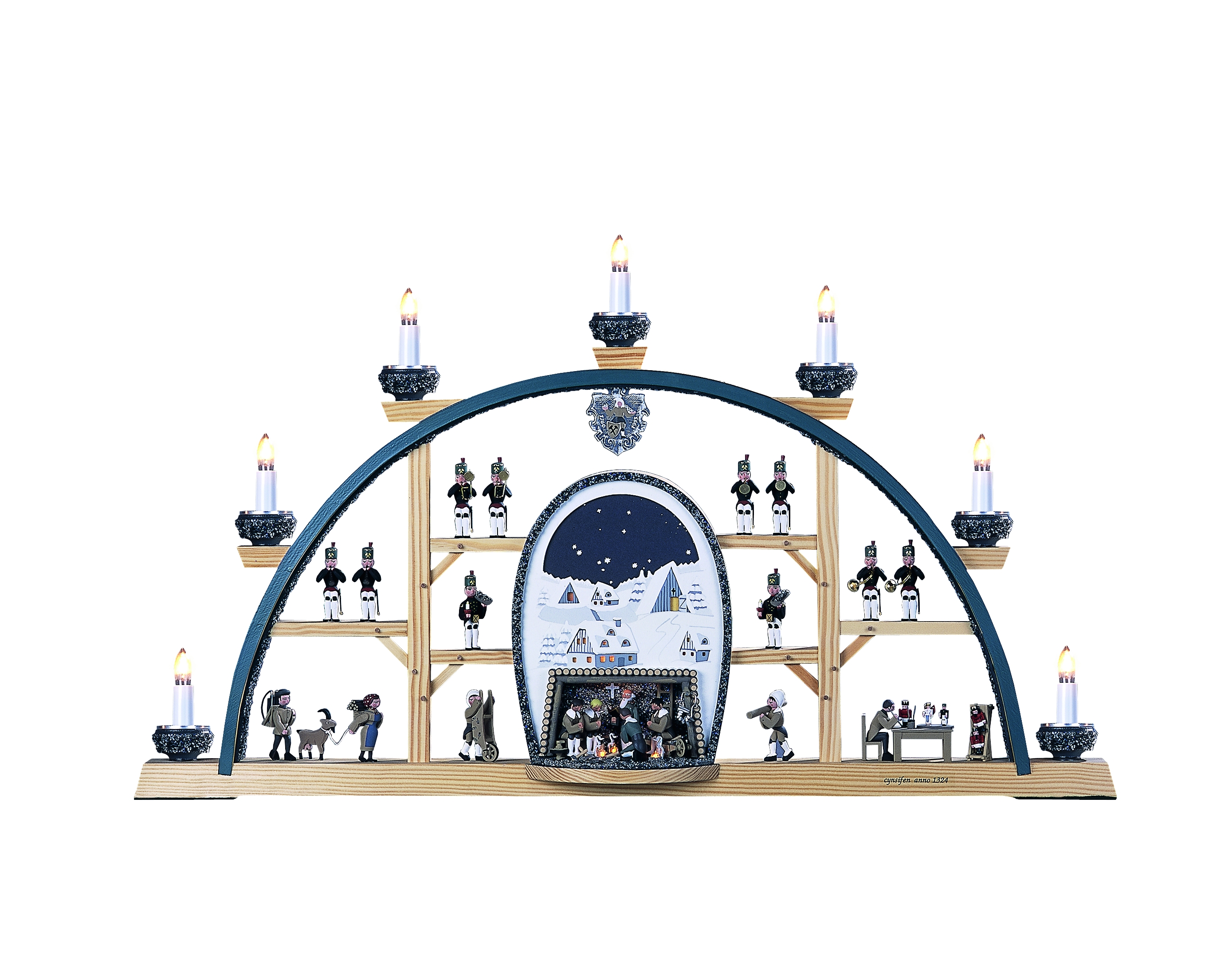
Image 2: Item no. 202/160/1/4 „cynsifen 1324” with mountain chapel and winter landscape, at the back Church of Seiffen (size 70 cm x 40 cm) with 8 electric candles including interior lighting
Christmas arches series "Ten Years of Klaus Kolbe Manufactory" 1990 - 2000
Image 1: Through Bohemia the settlement and reclamation of our area took place. The Cistercian monks of the Ossegg monastery contributed significantly to the first finds of tin and silver in the Ore Mountains and triggered the mining clamour.
Image 2: The increasing decline of mining forced the miners to pursue a second profession in order to secure their livelihood. In the Seiffen area the transition from mining to wood turning and toy making took place with the use of the abundant wood as a raw material to produce everyday commodities.
Image 3 and 1: Reminiscent for the challenges of the miner’s work is the miner figure working on site in the dark of the earth, extracting valuable silver and tin ores from the rocks with only a flail and iron. And the agricultural use of a very small piece of barren soil contributed to the miner´s family´s food supply.
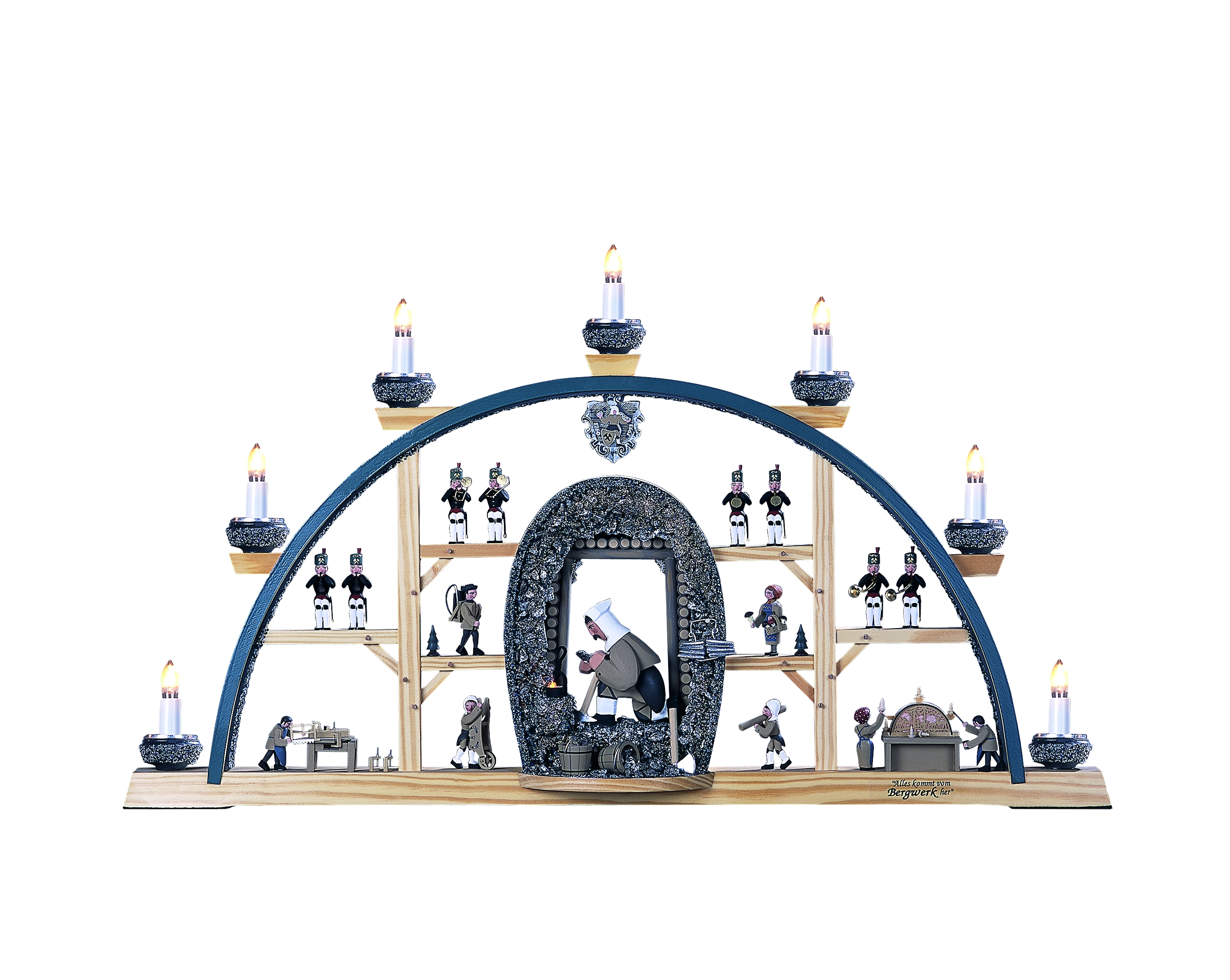
Image 3: Item no. 202/160/2/4 „Miner with treasure trove level” (size 70 cm x 40 cm) with 8 electric candles including interior lighting
Further Motives
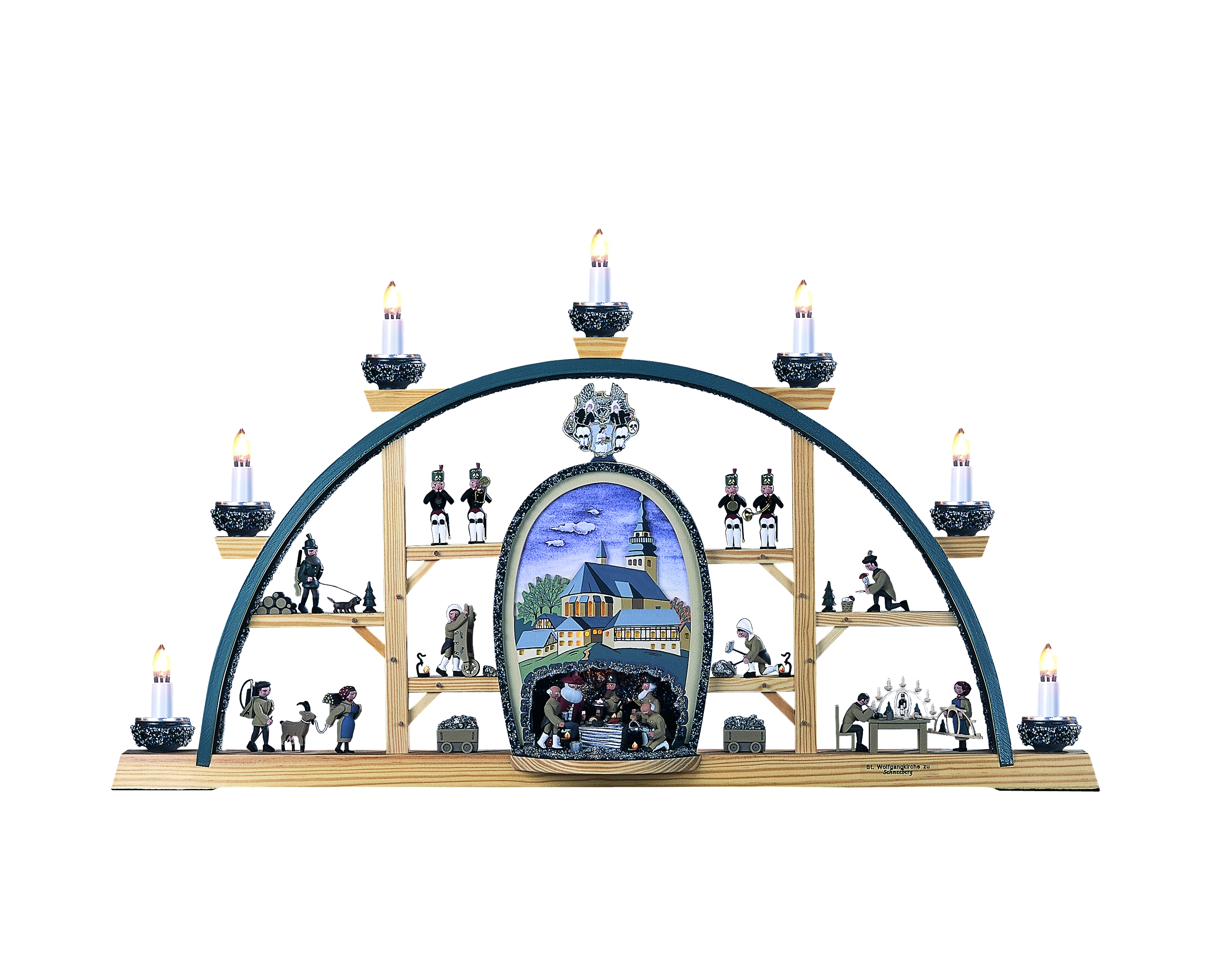
Item no. 202/160/4/1 “Summer in Schneeberg” (size 70 cm x 40 cm) with 8 electric candles including interior lighting, tunnel mouth hole painted on both sides
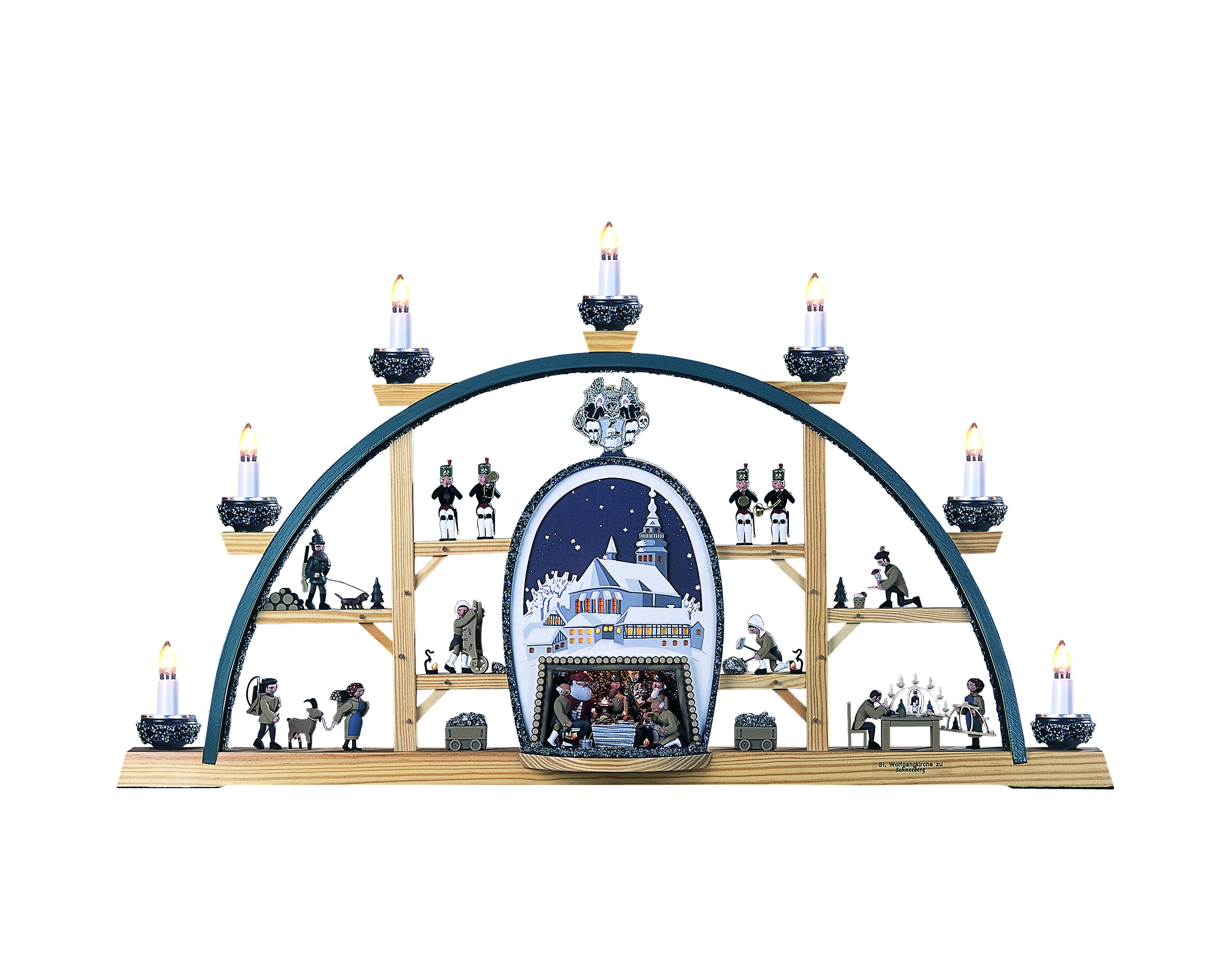
Item no. 202/160/4/2 “Winter in Schneeberg” (size 70 cm x 40 cm) with 8 electric candles including interior lighting, tunnel mouth hole painted on both sides
City of Schneeberg – St. Wolfgang Church
In the 15th and 16th centuries significant city foundations took place by the Saxon dukes. This is associated with the heydays of mining in the Ore Mountains resulting in an economic upswing in Saxony. Within only a few years these cities surrounded by silver mining transformed into major mountain towns like Schneeberg (1471), Annaberg (1496) and Marienberg (1521). As an expression of their wealth, monumental buildings were created there. Until today, these still shape the cityscape of the towns that once had been rich in silver.. The city of Schneeberg was founded in 1471 by Duke Albrecht of Saxony. In 1474 already, 1200 miners worked in and around Schneeberg in 232 different mines. From 1516 to 1540 the Church of St. Wolfgang was built and has shaped the cityscape since then. This landmark of Schneeberg is also the focus of the arch. Below an episode of Schneeberg's city history is displayed in a tunnel mouth hole. In 1477 miners of the Sankt-Georg-Treasure trove found a huge silver level of a size of 2 x 2 x 1 m and a weight of 400 centners. The find was so sensational that even Duke Albrecht hurried to Schneeberg to have a look at this miracle. He sat down at this "silver table" and was provided with food and drinks. It is said, he exclaimed: "Our Emperor Friedrich is powerful and rich, but he doesn't have such a stately table made of pure silver. "
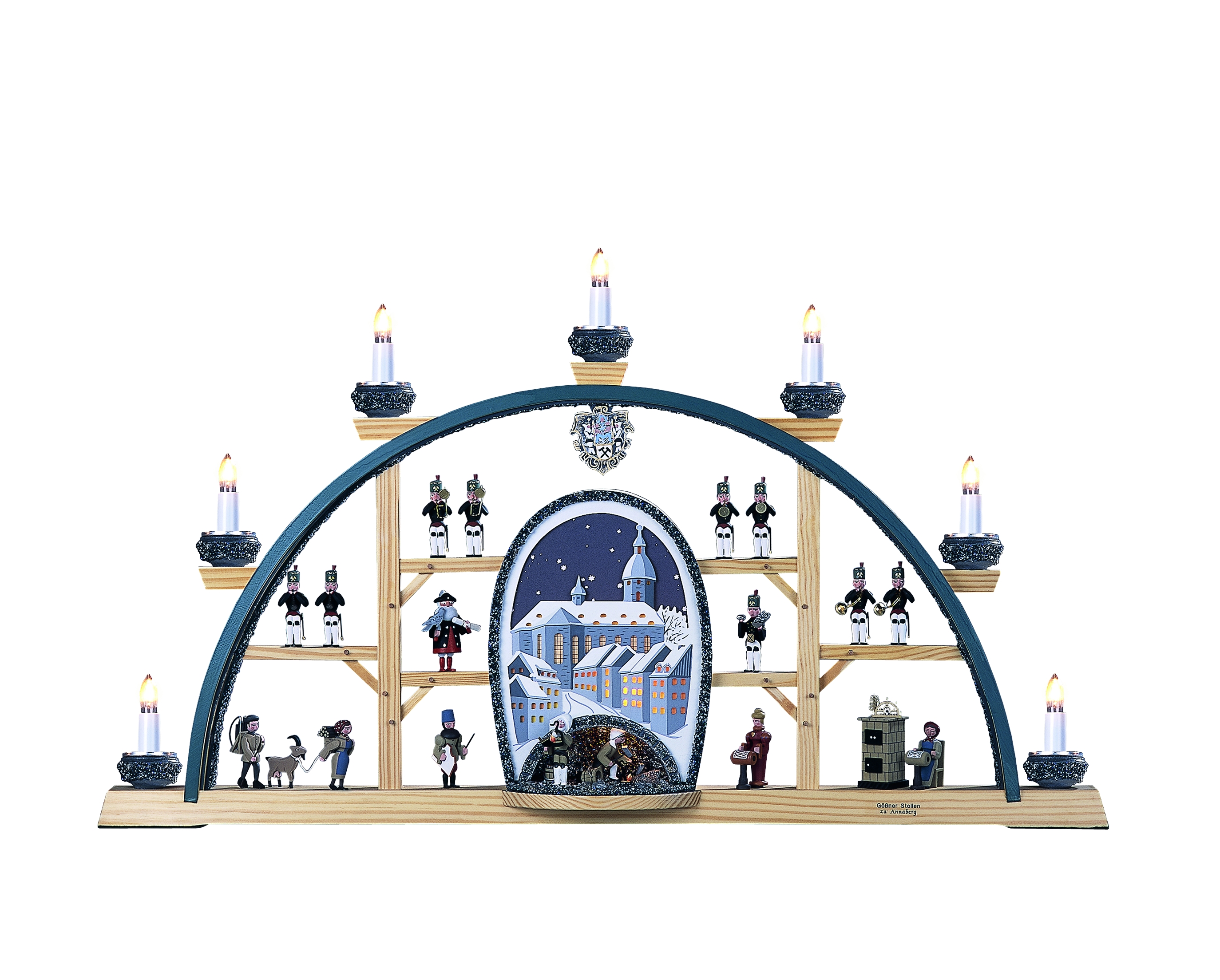
Item no. 202/160/3/1 “City of Annaberg” (size 70 cm x 40 cm) with 8 electric candles including interior lighting, tunnel mouth hole painted on both sides
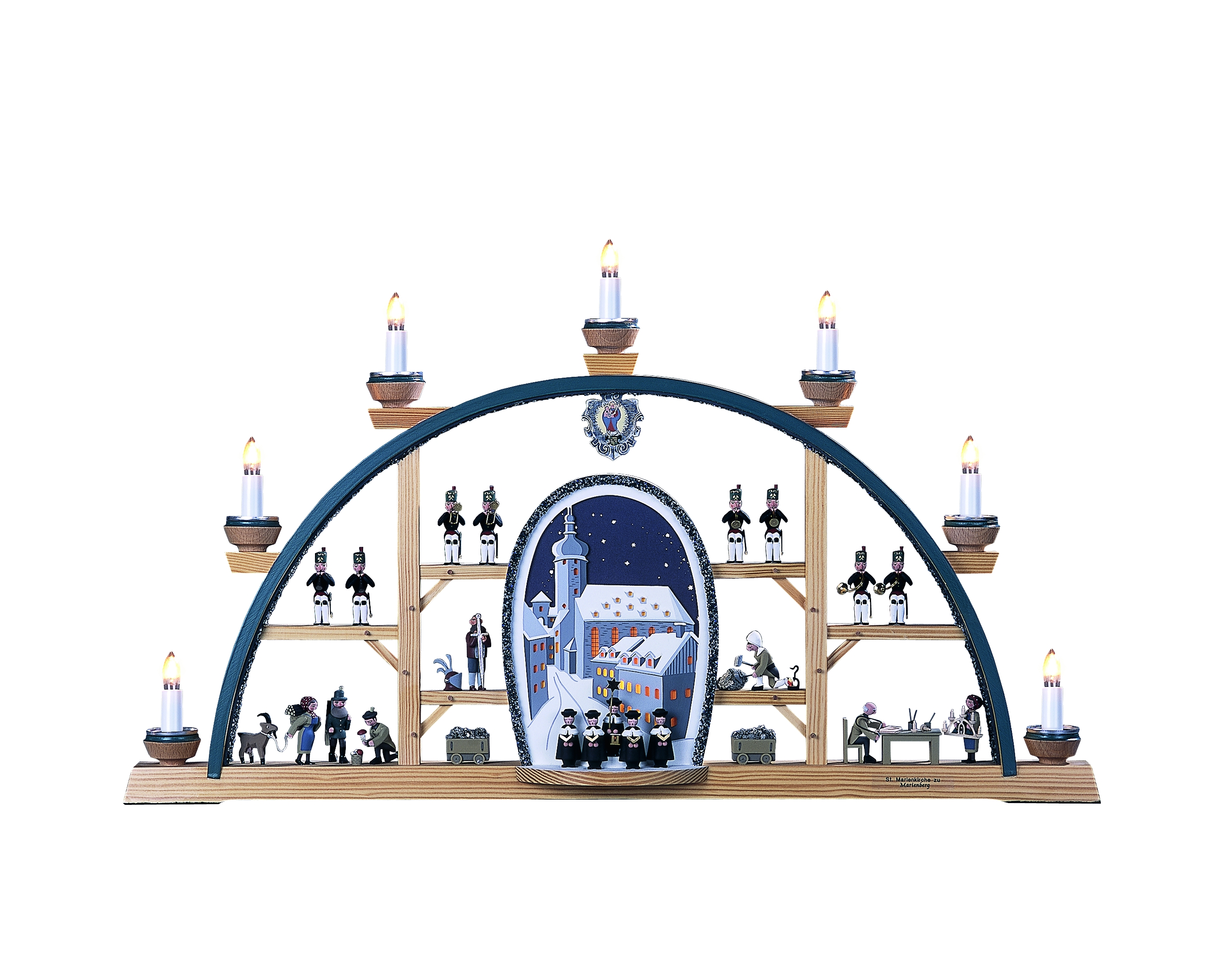
Item no. 202/160/6/1 “City of Marienberg” (size 70 cm x 40 cm) with 8 electric candles including interior lighting, tunnel mouth hole painted on both sides
City of Annaberg – Church of St. Annen
In 1496 Saxon Duke Georg (“the bearded”) prompted to found the city "Neustadt am Schreckenberg". This was due to first silver finds around 1492 in Schreckenberg, which then received the name “Sankt Annaberg” by an imperial coat of arms in 1501. Around 1500 Annaberg had already been one of the most important mining sites in the Ore Mountains besides Freiberg and Schneeberg. Annaberg's most outstanding architectural monument Church of Sankt Annen was built from quarry stones only between 1499 and 1525. It is the largest late Gothic hall church in Saxony and the center piece of our Christmas arch. The work of the German mathematician Adam Ries (1492-1559) was also closely connected with mining since he worked as a recess writer for the Annaberg Mining Business and owned a computing school. Barbara Uthmann (1514-1575), who became an important personality of Annaberg´s history as well was trained by Adam Ries in arithmetic and mining studies. As a publisher, she contributed significantly to the spread of the Erzgebirge bobbin lace and created a new livelihood for many mining families when mining increasingly went down. Besides the Church of St. Annen these two historical figures are also displayed in our Christmas arch.
City of Marienberg – Church of St. Marien
Marienberg is the youngest of these once significant mountain towns in the Ore Mountains. In 1519 the first silver finds in the area of Waldhufendorf Niederschletta also attracted numerous miners. In 1521, this fact motivated Duke Heinrich the Pious of Saxony to found a new mountain town. It was created on the land of Wüstenschletta and got named Marienberg. As early as 1523, the city received full city rights and full mining rights and owns a squared marketplace of 1.77 hectare. On a Swedish granite base, a larger-than-life bronze monument of the city's founder Duke Henry the Pious (1473–1541) was installed. In addition to representative secular buildings like the City Hall, the Princely House as the Duke's former hunting lodge and the Mining Authority were built. From 1558–1564 Church of Sankt Marien was built as well. The church is the youngest of the big, late Gothic hall churches in the Ore Mountains. Therefore, the monument of the city founder Duke Henry the Pious and the Church of St. Marien dominate in our Christmas arch, besides other mining and folkloric representations.
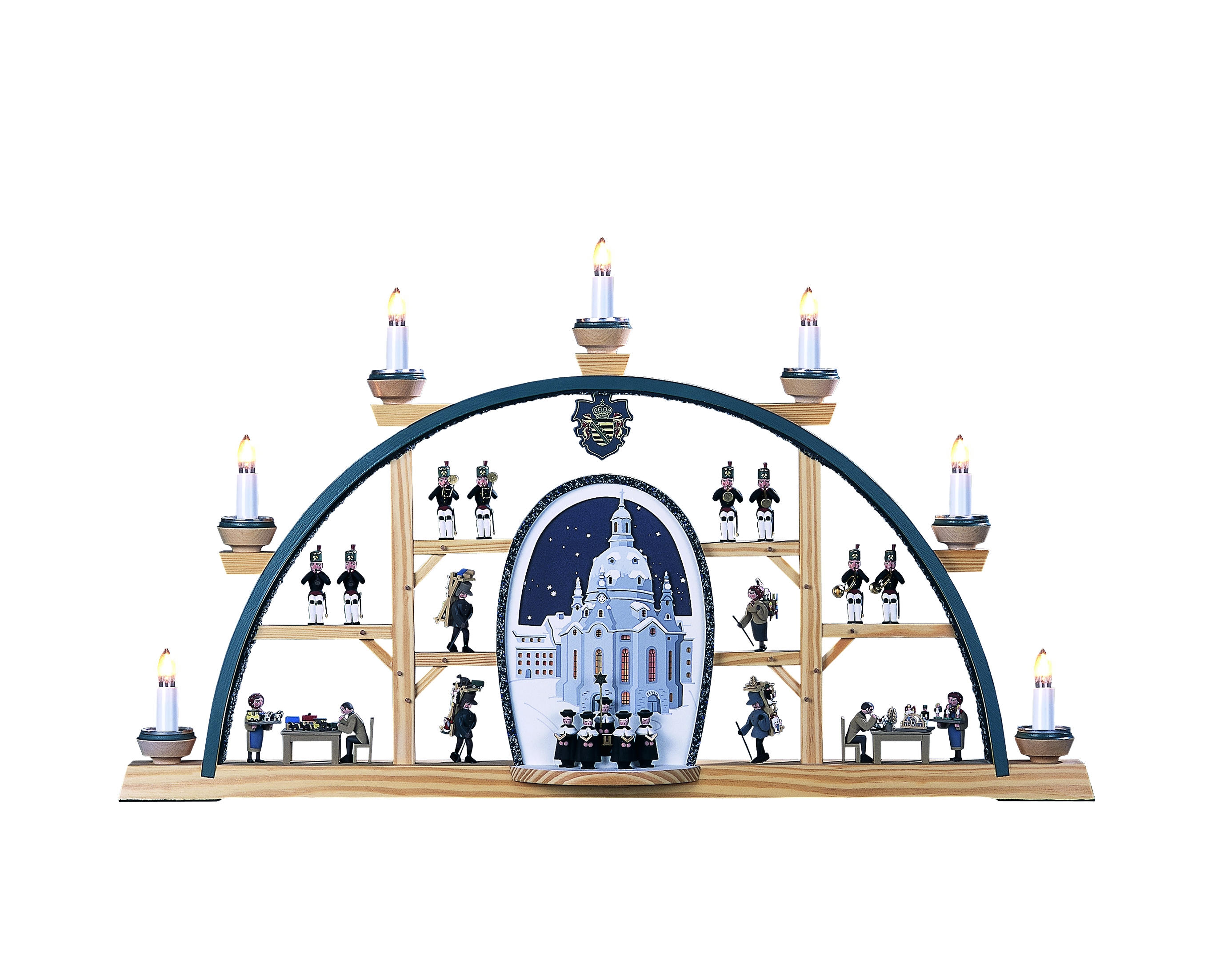
Item no. 202/160/5 Frauenkirche with four Seiffen toy makers around 1809 (size 70 cm x 40 cm) with 8 electric candles including interior lighting, tunnel mouth hole painted on both sides
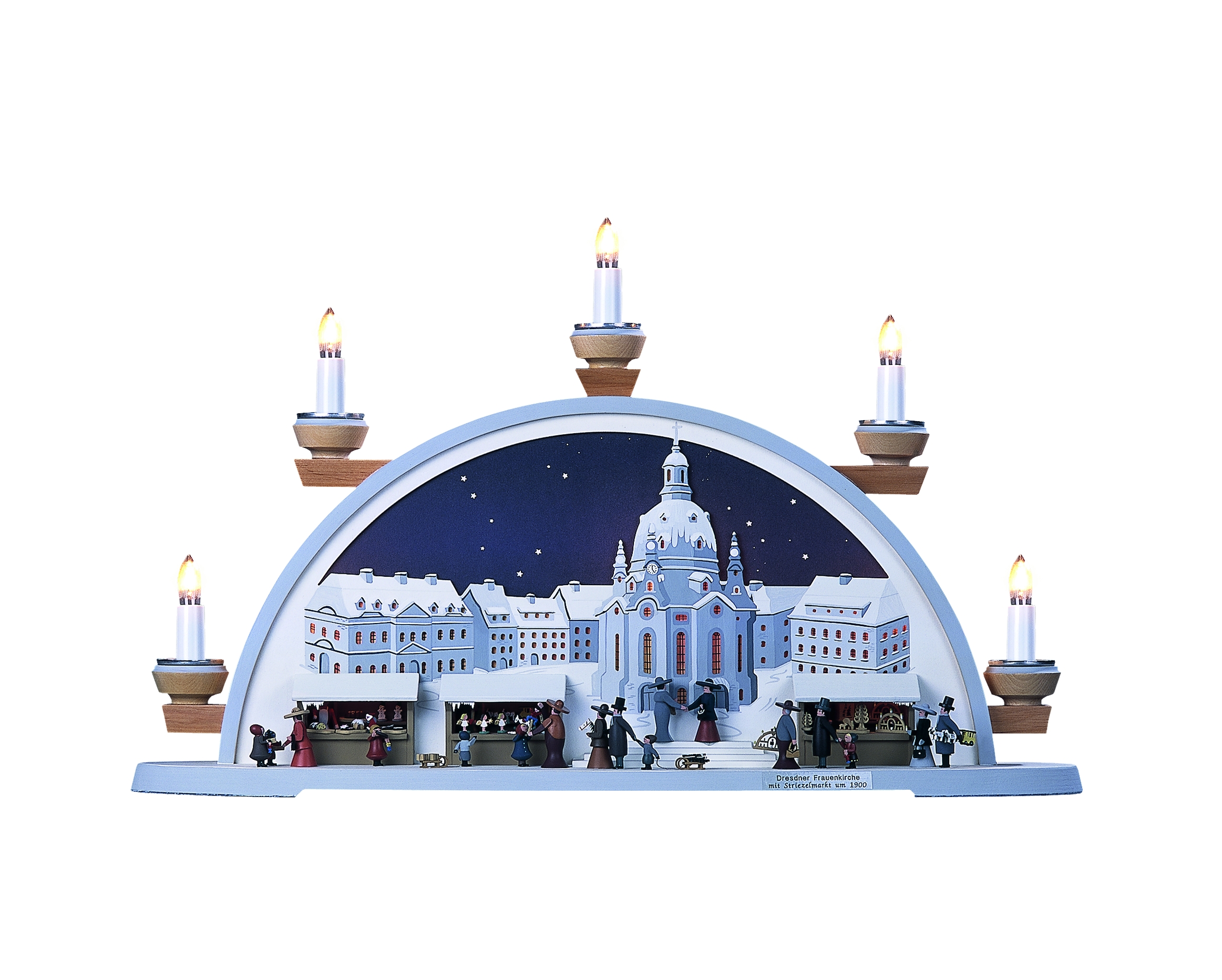
Item no. 202/250/1 "Frauenkirche with Striezelmarkt around 1900" (size 54 cm x 32 cm x 12 cm) with 8 electric candles including interior lighting
City of Dresden
Dresden is directly connected to the Ore Mountains. Not just as the state capital, but also for historical reasons. In 1908 the four toy makers "Johanna Christiane Schneider", "Gotthelf Friedrich Fichtner”, “Christian Friedrich Kämpe ” and “ Samuel Gottlieb Neubert ” received the permission to sell their products in front of the Frauenkirche for a period of one sunshine in order to avoid intermediary trade fees, which at that time had cost them a large part of their income. Therefore, we like to pay heartfelt attention to this event. Today's appearance of the City of Dresden with its baroque buildings was largely financed by the considerable funds that the State Treasury has received from silver mining in the Ore Mountains. The reconstruction of the Frauenkirche is an important step against forgetting history after its destruction in 1945. Thus, Dresden is a witness of the past, as well as a monument of the present. This is the reason, why the motif of the Frauenkirche with Striezelmarkt is found frequently throughout our product range.


